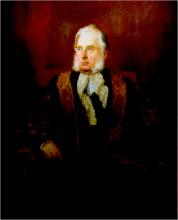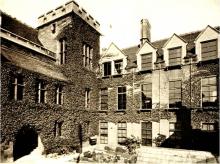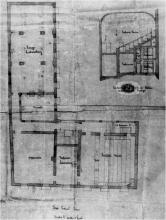by Dennis Moralee
from the booklet "A Hundred Years and More of Cambridge Physics".
The Foundation of the Cavendish Laboratory
"The systematic teaching of practical physics is a modern development. Until the second half of the nineteenth century was well begun, no teaching laboratory and no regular course of instruction were known."
So used are we nowadays to the large, carefully organised and elaborately equipped University teaching laboratory that this statement (with which the original History of the Cavendish begins) seems somewhat startling. But in fact it understates the case, for, until that period just over a century ago, no central facilities of any kind existed for the practice of experimentally based physics. The Physics Faculty, with its essential components - the laboratories and workshops, the lecture rooms and libraries, the stores and offices - is, like all the other faculties, quite a modern innovation. All the immense amount of scientific knowledge built up before the 1870's was the result of individual work in essentially private labs. The wealthy amateur physicist, such as Joule or Cavendish, would have a laboratory at his home, while the academic scientist would work in his college rooms. The tremendous contributions to science produced by, for example, Newton at Trinity, Young at Emmanuel, and Stokes at Pembroke were all accomplished in their own accommodation and largely by themselves. Any assistance they might have would be relatively unskilled - for instance Newton's poor eyesight led him to employ others to describe the results of his optical work to him. But, astonishingly, helping an acknowledged master of experimentation was the only way open to a student physicist to receive any teaching in experimental techniques whatsoever. Indeed such knowledge was actively discouraged by some academics, such as the great Cambridge mathematician Dr. Isaac Todhunter, who said: "Experimentation is unnecessary for the student. The student should be prepared to accept whatever the master told him."
Around the middle of the nineteenth century a great deal of discussion arose about the practical training of scientists and engineers at all levels. The British Association, the Great Exhibition, and the Science Museum all came out of this enthusiasm for spreading scientific knowledge. So too came our own Natural Sciences Tripos in 1851, but teaching for the new Tripos was, in physics at least, entirely theoretical, based on the ancient mixture of public lectures and private reading. The only university to have anything like an organised laboratory was Glasgow, where, in the 1840's, William Thompson, later Lord Kelvin, "took over an old wine cellar in his predecessor's house.... threw out the bins, installed a water supply and a sink, and called the room a physical laboratory." Many students were taught in this laboratory and some remarkable work produced, but still the student worked only as the Professor's assistant, not on any organised course, and only a few students could be accommodated in this way.
Twenty-five years later pressure for the establishment of organised practical teaching was irresistible. Oxford and Cambridge reacted in their own fashions to it. Oxford began building the Clarendon, and in Cambridge the Senate formed a committee to look into the question. When, in 1869, the committee reported, it was clearly in favour of creating a Cambridge Physics Laboratory, recommending the "founding of a special Professorship, and of supplying the Professor with the means of making his teaching practical - in other words, of giving him a demonstrator, a lecture-room, a laboratory, and several class-rooms, with a sufficient stock of apparatus." However, at this time the University's finances were not very healthy, and the report had to be shelved. How long things would have remained in this state is not known, but after 18 months, the then Chancellor wrote to the University offering to meet the estimated cost which was the frightening sum of £6,300. The Chancellor was the seventh Duke of Devonshire, himself a Smith's prize winner and Senior Wrangler, and a distant relative of Henry Cavendish. Indeed 'Cavendish' was the family name, and so, finally, the new laboratory became known as the Cavendish.
All this created, of course, a great deal of interest in Cambridge, particularly among the group of young mathematicians, mostly recent graduates, who were likely to be the first students at the new lab. It might at first seem surprising that the prospective students should nearly all be mathematicians, and in addition mostly graduates, but maths had, at that time, a very firm hold on Cambridge life. Introduced in 1747, the Mathematical Tripos eventually became the course for all serious students. Indeed, until 1850 no student could obtain an honours degree without first qualifying in the Maths Tripos, and those of a non-mathematical disposition either "ploughed it", like Macaulay, or entirely refused to graduate, like Gray. Mathematics was described as the vampire of the Cambridge schools, and had absorbed not only philosophy, but also the arts and natural sciences. The nineteenth century finally saw the breaking of this monopoly with the establishment of several Triposes for Classics (1822), Moral Sciences (1851), and, as we have seen, Natural Sciences, also in 1851. But the development of these Triposes was relatively slow, and even in 1874 the N.S.T. could boast only 19 students, compared with some 1500 a century later. The Mathematical Tripos itself, with its rigid order of merit, was an extremely competitive one and undergraduates in it could not fairly be expected to do practical work as well. So the first students at the projected Cavendish Laboratory were bound to be Mathematics graduates.
There was, naturally, much speculation about the choice of the new Professor of Experimental Physics. Kelvin was the most likely candidate, but on being approached in private, refused in order to stay in Glasgow. Another likely candidate was Lord Rayleigh, a brilliant mathematician and physicist who had left Cambridge to work in his private laboratory at his country seat in Essex. When the appointment was eventually announced, the reaction was, if anything, one of disappointment. The new Professor, James Clerk Maxwel1, was relatively unknown. He had, it was true, been Senior Wrangler in 1854, joint Smith's prizeman and a much respected mathematician, but he had not since made any great name for himself - his major and astounding books on Electricity and Kinetic Theory had yet to be published. Moreover, the six years before his appointment had been spent in isolation at his Scottish home. Actually during this time he had, as an examiner for the Mathematical Tripos, done much to change the emphasis of the examination to more physical topics. His appointment was announced on March 8th 1871, and in spite of the initial disappointment, his inaugural lecture was looked forward to by his likely students as much as by the rest of the Cambridge scientists.



